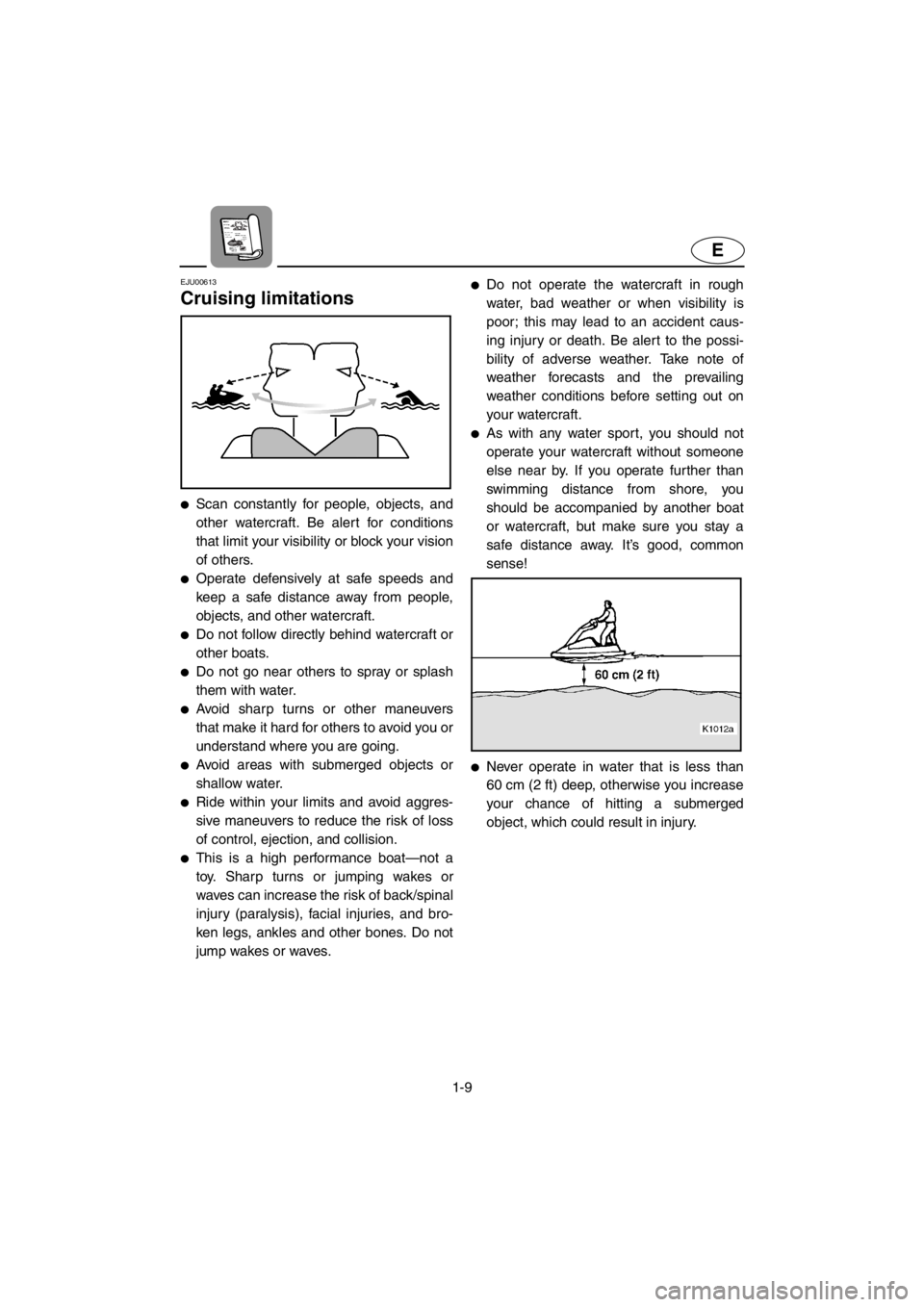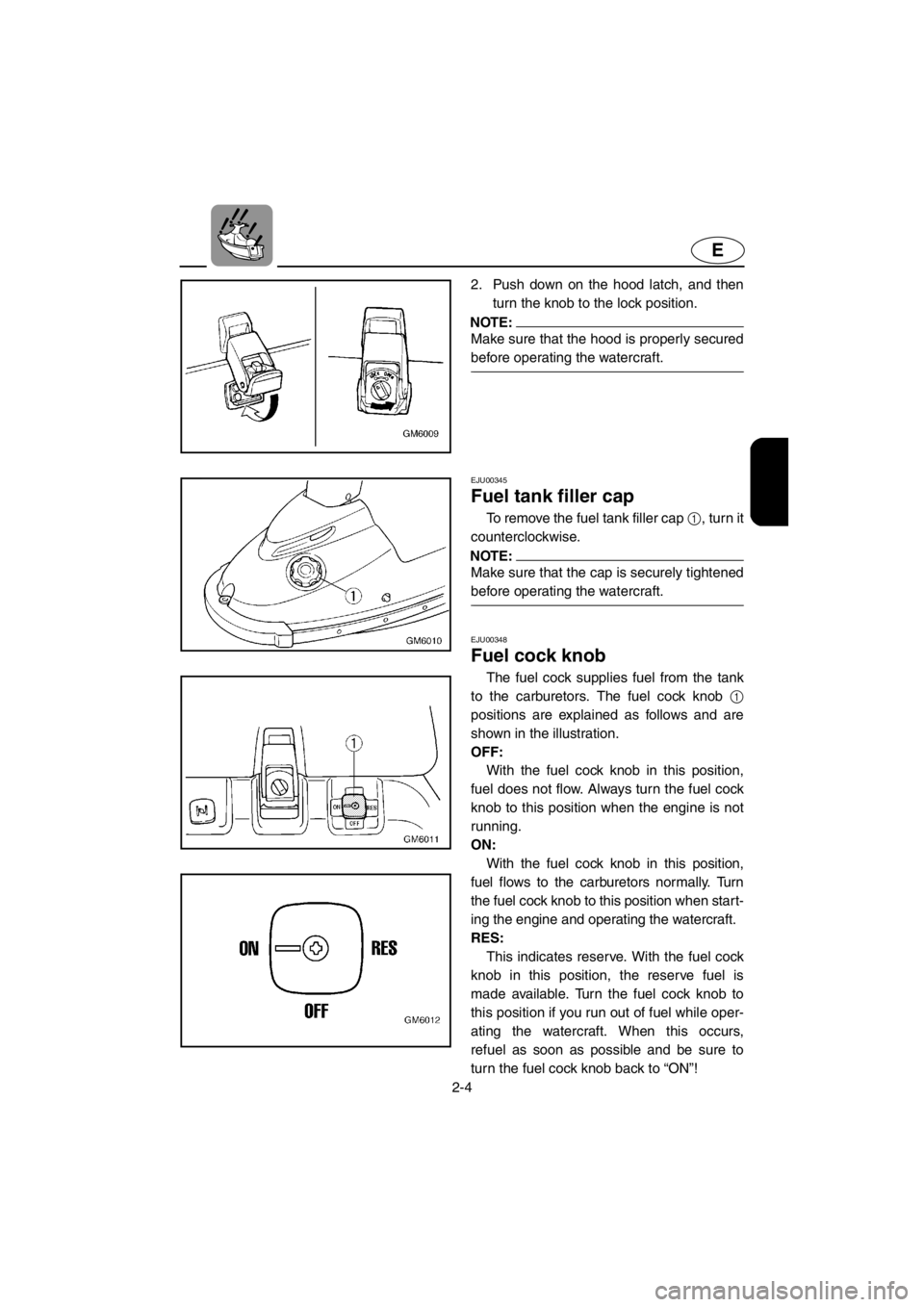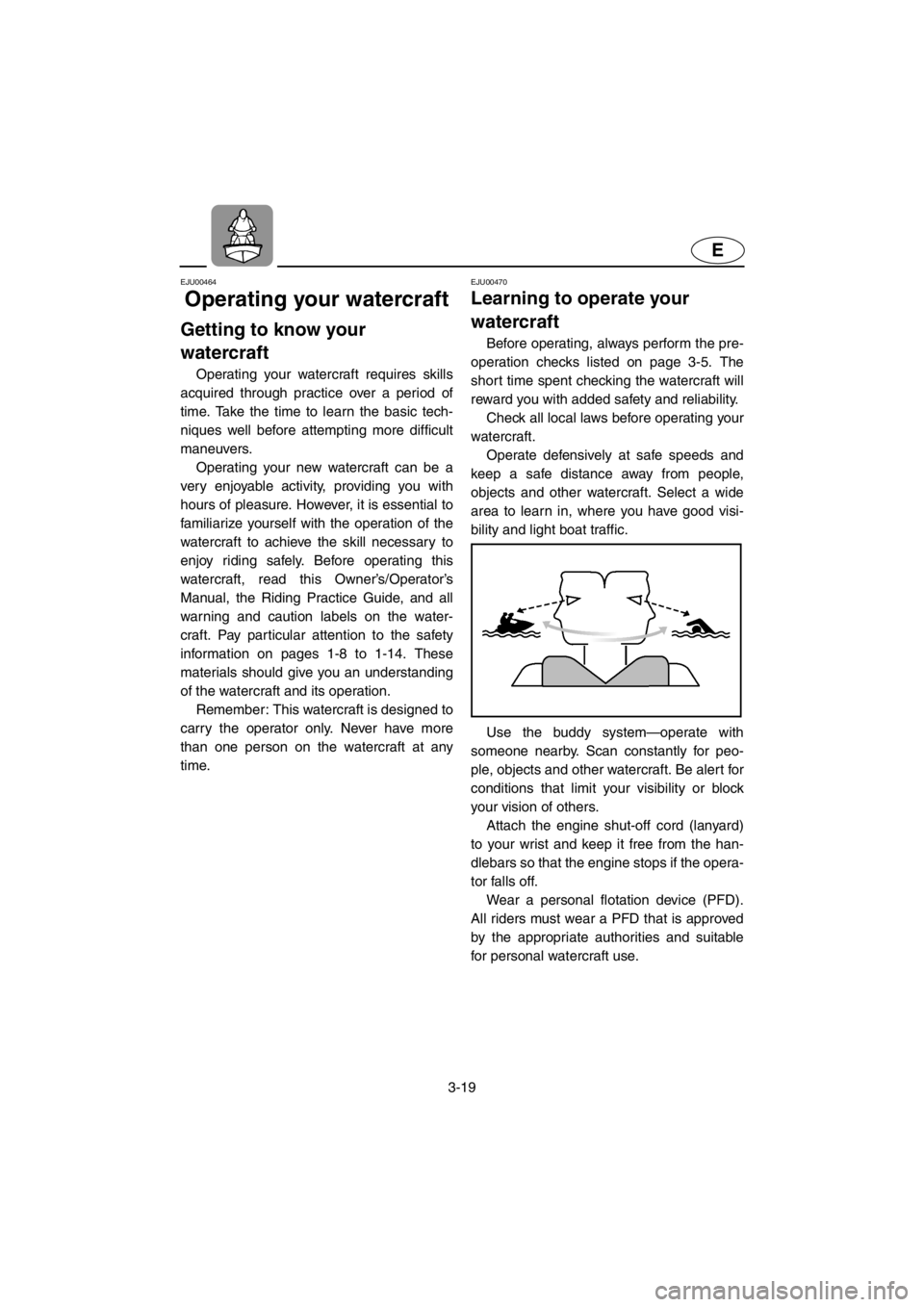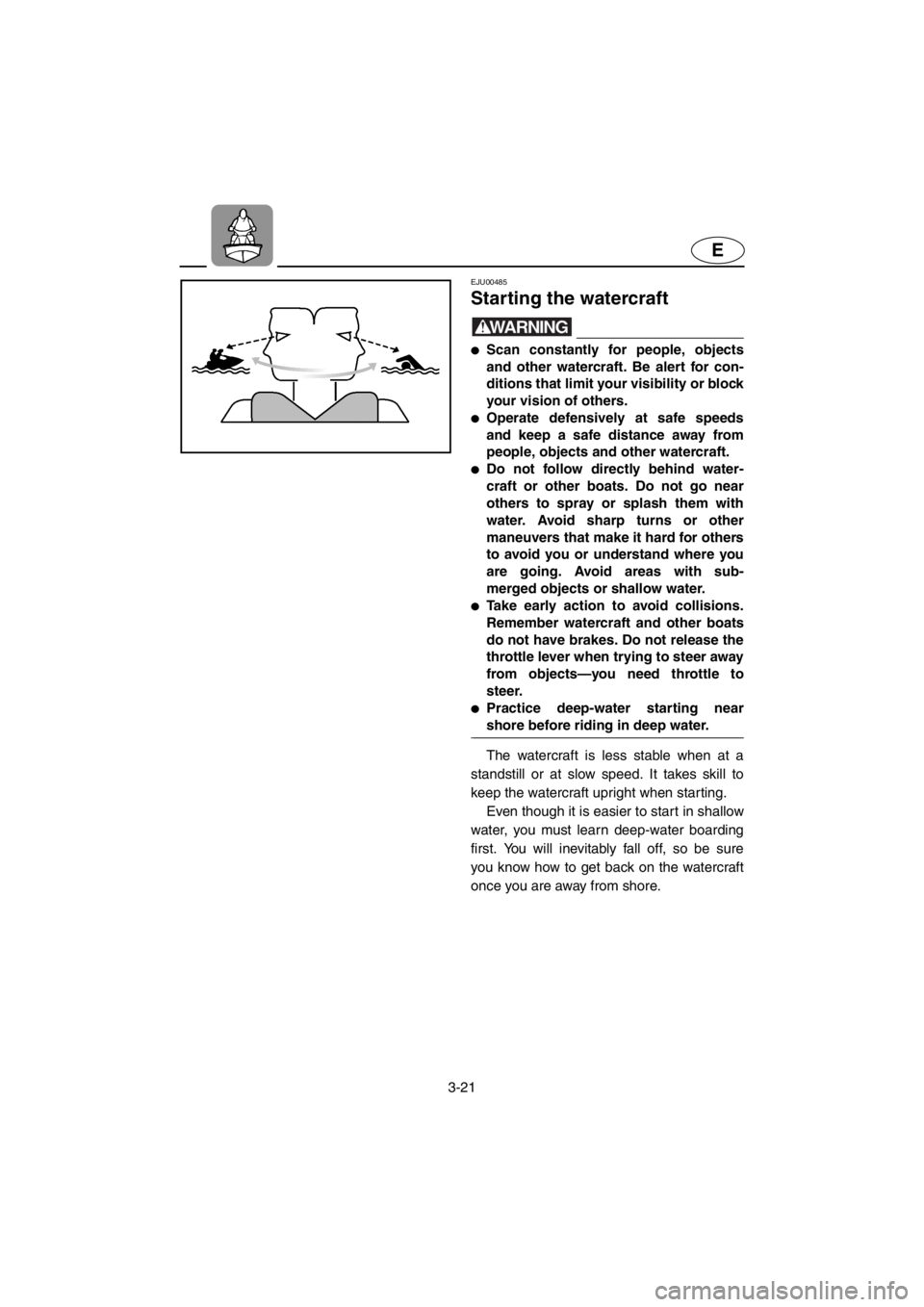Page 16 of 107

1-9
E
EJU00613
Cruising limitations
●Scan constantly for people, objects, and
other watercraft. Be alert for conditions
that limit your visibility or block your vision
of others.
●Operate defensively at safe speeds and
keep a safe distance away from people,
objects, and other watercraft.
●Do not follow directly behind watercraft or
other boats.
●Do not go near others to spray or splash
them with water.
●Avoid sharp turns or other maneuvers
that make it hard for others to avoid you or
understand where you are going.
●Avoid areas with submerged objects or
shallow water.
●Ride within your limits and avoid aggres-
sive maneuvers to reduce the risk of loss
of control, ejection, and collision.
●This is a high performance boat—not a
toy. Sharp turns or jumping wakes or
waves can increase the risk of back/spinal
injury (paralysis), facial injuries, and bro-
ken legs, ankles and other bones. Do not
jump wakes or waves.
●Do not operate the watercraft in rough
water, bad weather or when visibility is
poor; this may lead to an accident caus-
ing injury or death. Be alert to the possi-
bility of adverse weather. Take note of
weather forecasts and the prevailing
weather conditions before setting out on
your watercraft.
●As with any water sport, you should not
operate your watercraft without someone
else near by. If you operate further than
swimming distance from shore, you
should be accompanied by another boat
or watercraft, but make sure you stay a
safe distance away. It’s good, common
sense!
●Never operate in water that is less than
60 cm (2 ft) deep, otherwise you increase
your chance of hitting a submerged
object, which could result in injury.
E_GM6-1.fm Page 9 Tuesday, July 11, 2000 10:49 AM
Page 24 of 107
2-1
E
EJU00327
Location of main components
1Rope hole
Use to attach rope for transporting or mooring.
2Storage pouch
3Steering pole
Adjusts to suit operator’s riding posture.
4Handlebars
Use to control direction.
5Riding tray
Stand or kneel here for balance.
6Fuel tank filler cap
7Hood
8Steering cover9Hood latch
Locks the hood.
0Jet thrust nozzle
Changes the direction of jet thrust according
to handlebar position to steer the watercraft.
ACooling water pilot outlet
Use to verify cooling water flow.
BIntake grate
Prevents debris from getting into the jet pump.
CJet intake
DRide plate
EDrive shaft
Transmits power from the engine to the jet
pump.
E_GM6-2.fm Page 1 Tuesday, July 11, 2000 10:51 AM
Page 26 of 107
2-3
E
EJU00328
Operation of controls and
other functions
EJU00338
Hood
The hood is secured at the rear by a
latch.
Lift the steering pole and support it with
the lock pin before removing the hood.
To remove the hood:
1. Turn the latch knob 1 to the open posi-
tion, and then pull up on the hood latch 2
to unlatch the hood.
2. Grasp the hood using the handgrips 3
provided at the front and rear side of the
hood. Lift the hood up and to the rear to
remove it.
To install the hood:
1. Position the hood on the deck so the two
projections at the front of the hood fit
under the two stays on the deck.
E_GM6-2.fm Page 3 Tuesday, July 11, 2000 10:51 AM
Page 27 of 107

2-4
E
2. Push down on the hood latch, and then
turn the knob to the lock position.
NOTE:@Make sure that the hood is properly secured
before operating the watercraft.
@
EJU00345
Fuel tank filler cap
To remove the fuel tank filler cap 1, turn it
counterclockwise.
NOTE:@Make sure that the cap is securely tightened
before operating the watercraft.
@
EJU00348
Fuel cock knob
The fuel cock supplies fuel from the tank
to the carburetors. The fuel cock knob 1
positions are explained as follows and are
shown in the illustration.
OFF:
With the fuel cock knob in this position,
fuel does not flow. Always turn the fuel cock
knob to this position when the engine is not
running.
ON:
With the fuel cock knob in this position,
fuel flows to the carburetors normally. Turn
the fuel cock knob to this position when start-
ing the engine and operating the watercraft.
RES:
This indicates reserve. With the fuel cock
knob in this position, the reserve fuel is
made available. Tur n the fuel cock knob to
this position if you run out of fuel while oper-
ating the watercraft. When this occurs,
refuel as soon as possible and be sure to
turn the fuel cock knob back to “ON”!
E_GM6-2.fm Page 4 Tuesday, July 11, 2000 10:51 AM
Page 31 of 107
2-8
E
EJU00357
Steering pole
The steering pole varies in height with the
operator’s posture, enabling the operator to
assume various riding positions.
When removing the hood for pre-opera-
tion checks, maintenance, etc., lift the steer-
ing pole 1 and use the lock pin 2 to
support it. Move the lock pin into the detent.
Make sure the lock pin is returned to the
stowed position after installing the hood.
E_GM6-2.fm Page 8 Tuesday, July 11, 2000 10:51 AM
Page 39 of 107
3-4
E
Filling the fuel tank
CAUTION:@Be careful when refueling. Avoid getting
water or other contaminants in the fuel
tank. Contaminated fuel can cause poor
running or engine damage.
@
1. Lift the steering pole and support it with
the lock pin.
2. Remove the hood.
3. Open the fuel tank filler cap, and slowly
add the premixed fuel to the fuel tank.
4. Stop filling when the fuel level just
reaches the bottom of the filler tube.
NOTE:@●The hood must be removed in order to
watch the fuel level in the fuel tank while
adding fuel.
●Be careful not to spill fuel or overfill the
tank.
●Do not fill into the filler tube because fuel
could overflow.
@
Fuel tank capacity:
Total: 18 L (4.8 US gal, 4.0 Imp gal)
Reserve: 5.5 L (1.45 US gal, 1.21 Imp gal)
E_GM6-3.fm Page 4 Tuesday, July 11, 2000 10:52 AM
Page 54 of 107

3-19
E
EJU00464
Operating your watercraft
Getting to know your
watercraft
Operating your watercraft requires skills
acquired through practice over a period of
time. Take the time to learn the basic tech-
niques well before attempting more difficult
maneuvers.
Operating your new watercraft can be a
very enjoyable activity, providing you with
hours of pleasure. However, it is essential to
familiarize yourself with the operation of the
watercraft to achieve the skill necessary to
enjoy riding safely. Before operating this
watercraft, read this Owner’s/Operator’s
Manual, the Riding Practice Guide, and all
warning and caution labels on the water-
craft. Pay particular attention to the safety
information on pages 1-8 to 1-14. These
materials should give you an understanding
of the watercraft and its operation.
Remember: This watercraft is designed to
carry the operator only. Never have more
than one person on the watercraft at any
time.
EJU00470
Learning to operate your
watercraft
Before operating, always perform the pre-
operation checks listed on page 3-5. The
short time spent checking the watercraft will
reward you with added safety and reliability.
Check all local laws before operating your
watercraft.
Operate defensively at safe speeds and
keep a safe distance away from people,
objects and other watercraft. Select a wide
area to learn in, where you have good visi-
bility and light boat traffic.
Use the buddy system—operate with
someone nearby. Scan constantly for peo-
ple, objects and other watercraft. Be alert for
conditions that limit your visibility or block
your vision of others.
Attach the engine shut-off cord (lanyard)
to your wrist and keep it free from the han-
dlebars so that the engine stops if the opera-
tor falls off.
Wear a personal flotation device (PFD).
All riders must wear a PFD that is approved
by the appropriate authorities and suitable
for personal watercraft use.
E_GM6-3.fm Page 19 Tuesday, July 11, 2000 10:52 AM
Page 56 of 107

3-21
E
EJU00485
Starting the watercraft
WARNING@●Scan constantly for people, objects
and other watercraft. Be alert for con-
ditions that limit your visibility or block
your vision of others.
●Operate defensively at safe speeds
and keep a safe distance away from
people, objects and other watercraft.
●Do not follow directly behind water-
craft or other boats. Do not go near
others to spray or splash them with
water. Avoid sharp turns or other
maneuvers that make it hard for others
to avoid you or understand where you
are going. Avoid areas with sub-
merged objects or shallow water.
●Take early action to avoid collisions.
Remember watercraft and other boats
do not have brakes. Do not release the
throttle lever when trying to steer away
from objects—you need throttle to
steer.
●Practice deep-water starting near
shore before riding in deep water.
@
The watercraft is less stable when at a
standstill or at slow speed. It takes skill to
keep the watercraft upright when starting.
Even though it is easier to start in shallow
water, you must learn deep-water boarding
first. You will inevitably fall off, so be sure
you know how to get back on the watercraft
once you are away from shore.
E_GM6-3.fm Page 21 Tuesday, July 11, 2000 10:52 AM